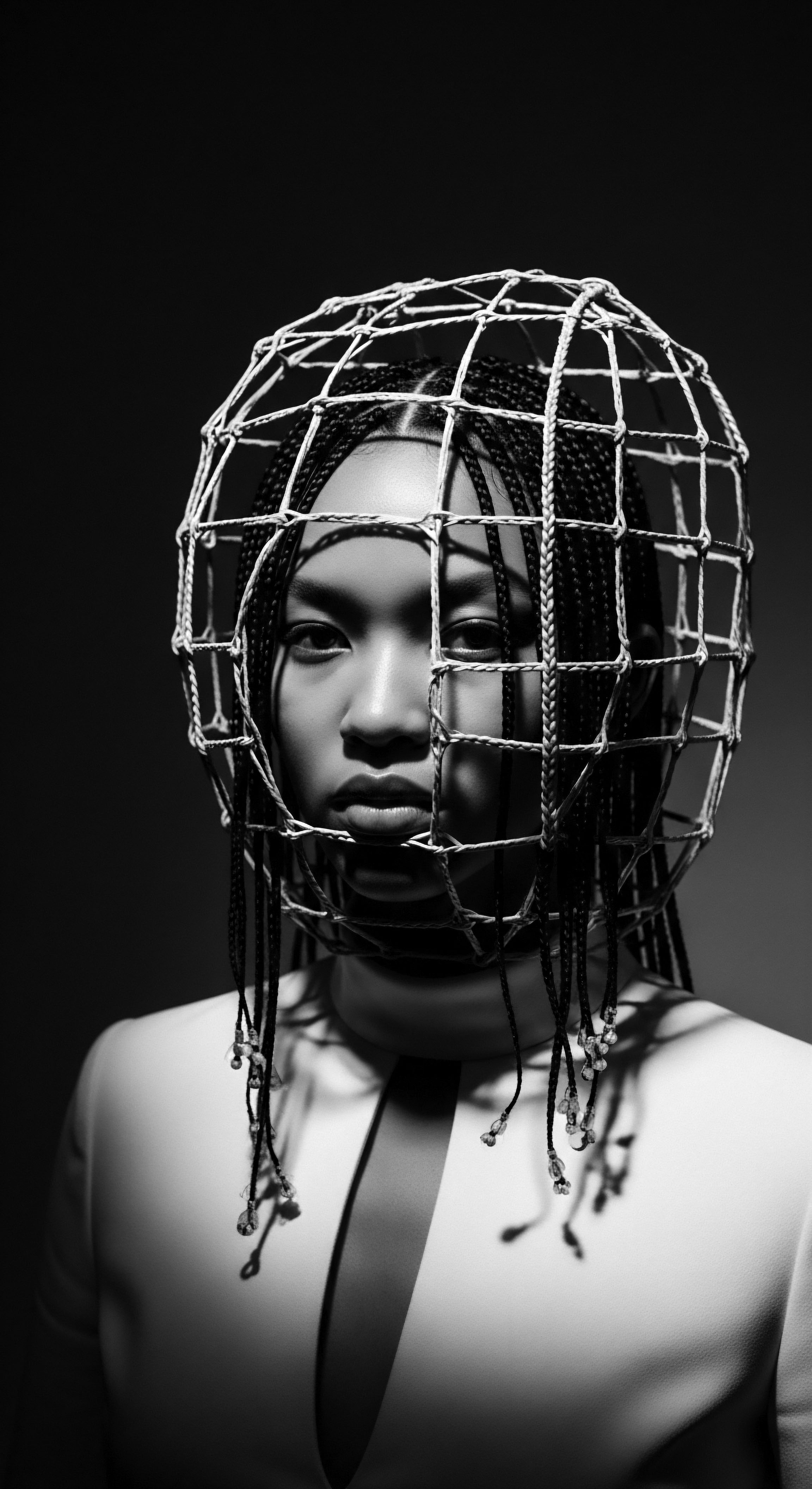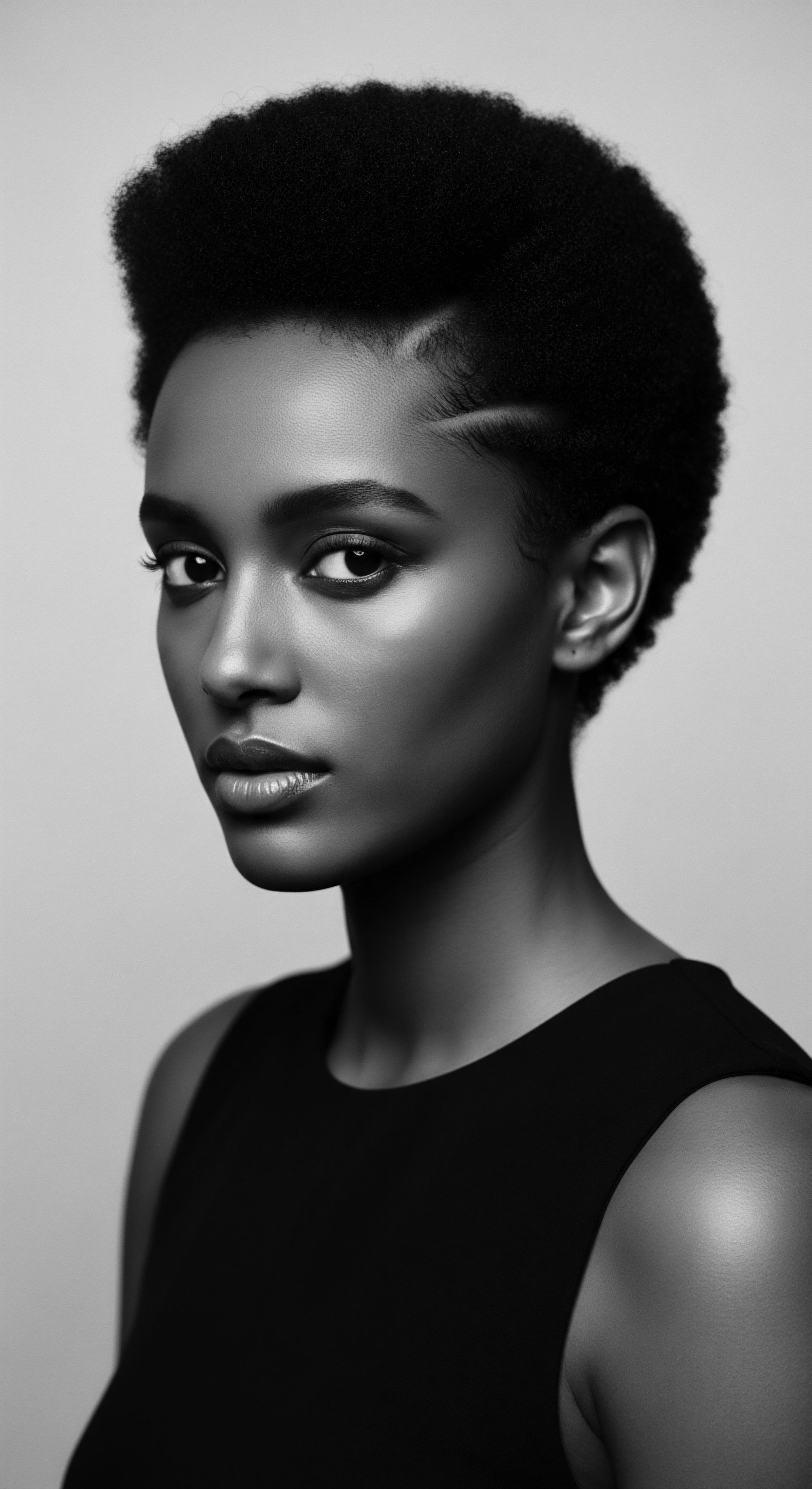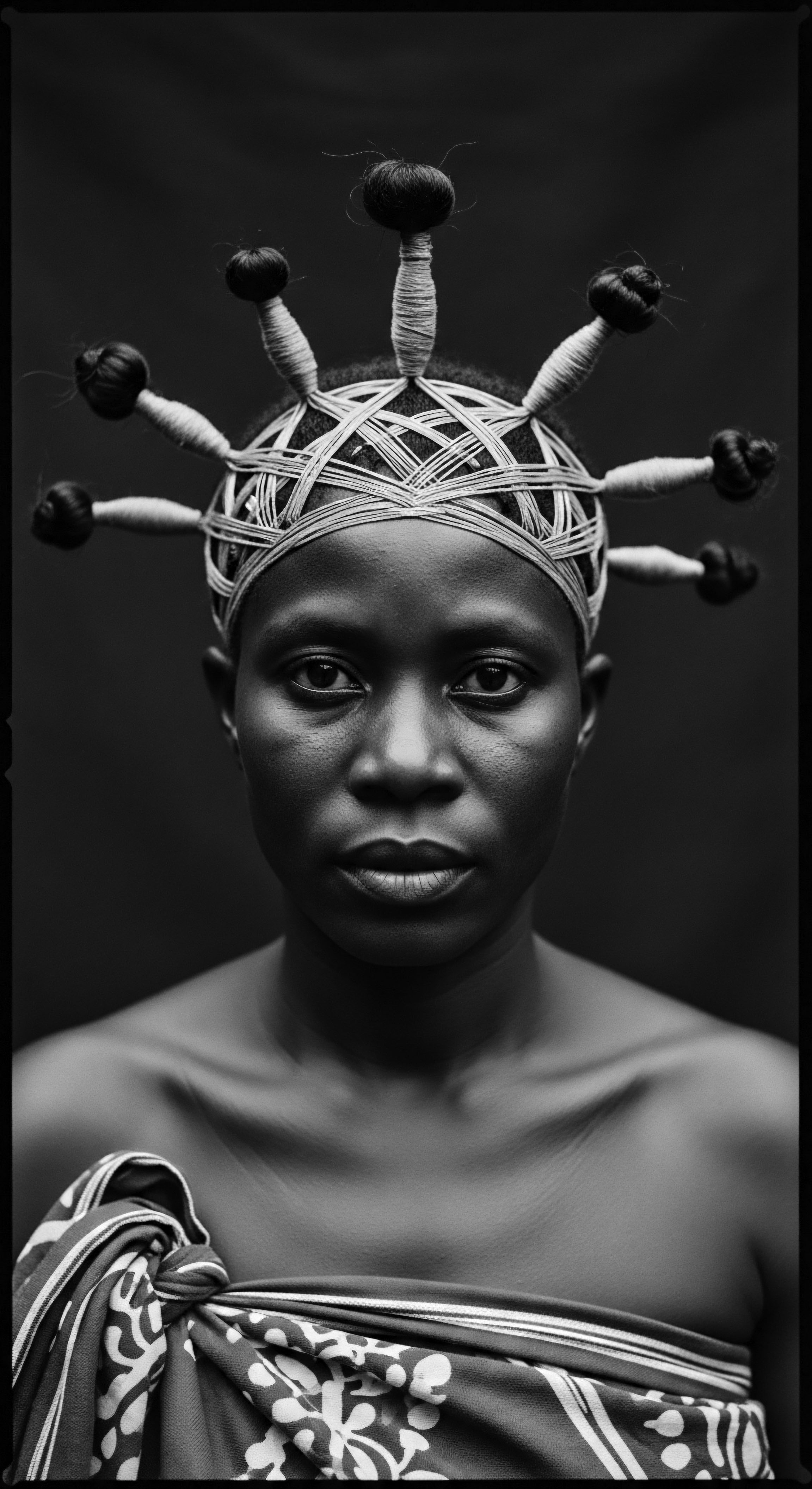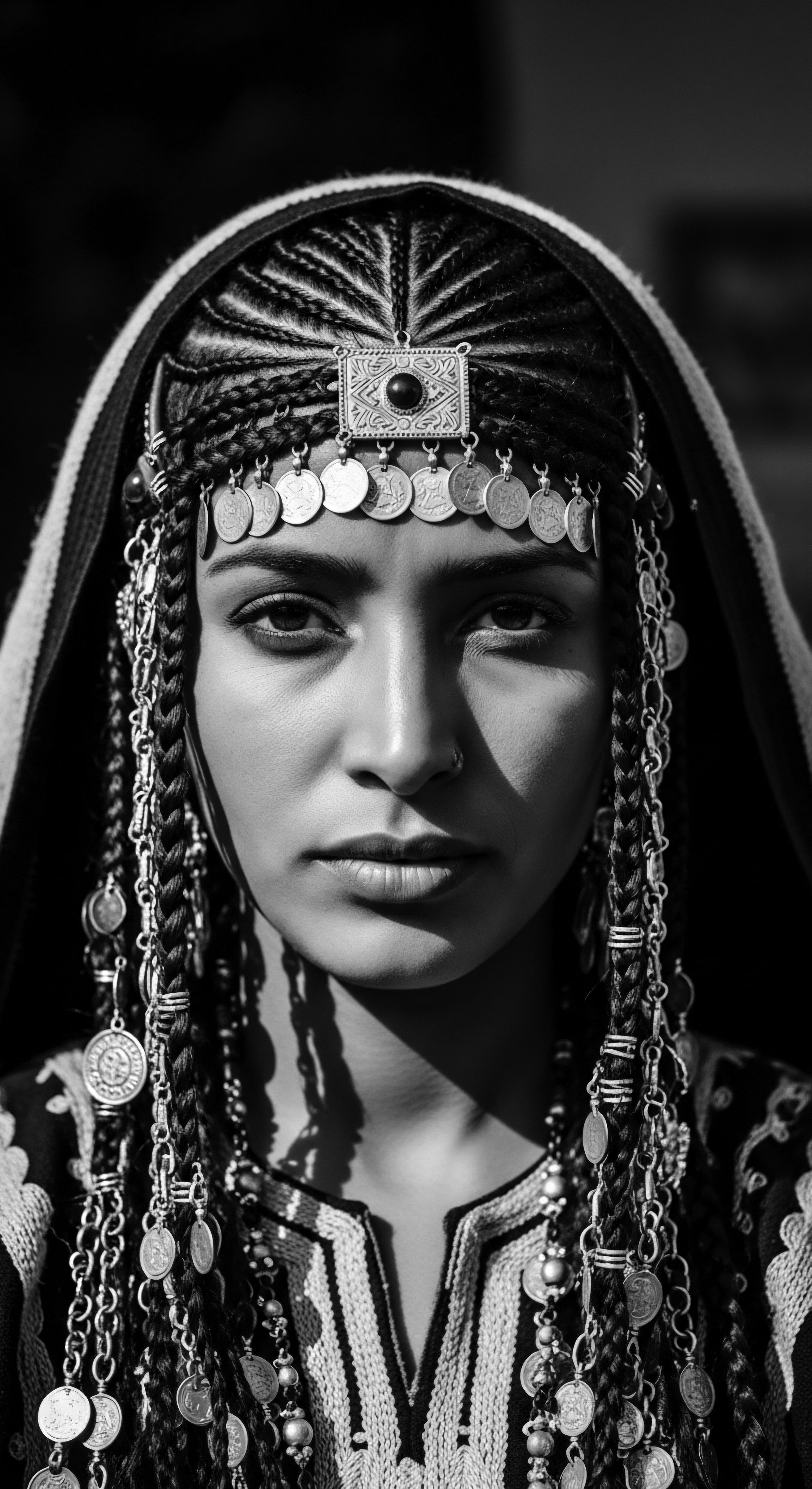
Roots
The journey into textured hair is a return to an ancestral wellspring, a deep reckoning with strands that carry the memory of sun, soil, and story. Each coil, each kink, a silent testament to survival, creativity, and identity. To truly grasp the shifts that altered our hair practices, we must first hear the whispers from the genesis, understanding that textured hair is not merely a biological structure, but a living archive of heritage. It holds the echoes of elemental biology, a design perfected over millennia to thrive in varied climates, shielding, insulating, and speaking volumes without utterance.
For countless generations, particularly across the African continent and among its diasporic progeny, hair was never a mere aesthetic choice. It functioned as a canvas for social status, spiritual belief, tribal affiliation, and even marital availability. The care rendered to hair was a ritual of connection, passing down wisdom through the skilled hands of elders, fingers moving with practiced grace through intricate patterns.
This heritage of interaction with our hair was organic, responsive, and deeply ingrained in community life. It was a dialogue between the hair, the hands, and the collective memory.

What Ancestral Hair Anatomy Unveils?
At its core, textured hair possesses a unique anatomical blueprint, distinct from straighter hair types. Unlike hair that grows with a perfectly circular cross-section, textured strands often exhibit an elliptical or even flattened shape. This anatomical variance contributes directly to the curl pattern, dictating how a strand spirals, kinks, or coils.
The cuticle layers, which are the protective scales on the hair’s outermost surface, also behave differently on highly textured hair, sometimes lifting more readily. This inherent characteristic, while part of natural design, renders textured hair more susceptible to moisture loss and tangling.
Understanding this elemental structure is not a modern scientific revelation alone; it is a validation of ancestral knowledge. Our forebears instinctively recognized the needs of their hair. They observed its thirst, its tendency to intertwine, and its need for gentle handling.
The traditional practices of oiling, twisting, and protective adornment were responses to these biological realities, crafted over centuries of lived experience and keen observation. These methods, born from intimate familiarity with the hair itself, formed the earliest haircare regimen.
Textured hair, with its unique anatomical makeup, carries ancestral blueprints of resilience and beauty.
Consider, for a moment, the Mbuti people of the Ituri Forest, whose reverence for hair is deeply rooted in their worldview. Their traditional styles, often adorned with natural elements from their environment, reflect a profound connection to the land and spirit, a testament to hair as a sacred extension of self (Turnbull, 1965). The act of styling became a communal rite, a moment of shared purpose and continuity.
The methods employed, from the selection of plant-based lubricants to the deliberate coiling techniques, were honed over countless generations, each movement carrying the weight of inherited wisdom. The hair, in this context, served as a living map of identity, charting one’s place within the community and spiritual landscape.

How Did Traditional Lexicons Shape Hair Understanding?
The language used to describe hair in ancestral communities was not merely descriptive; it was an extension of cultural meaning and connection. Before standardized classification systems, diverse communities possessed their own rich lexicons to differentiate and celebrate the myriad forms of textured hair. These terms often spoke to the hair’s feel, its appearance, or its symbolic association within the community. They were often tied to familial lineage or spiritual significance, far removed from purely commercial categorizations.
- Knotting ❉ In some West African traditions, specific knotting patterns in hair could denote marital status or communicate messages between communities.
- Locs ❉ Ancient Nubian and Egyptian cultures recognized the power and spiritual connection of hair allowed to grow in its natural coiled state, often associating it with divine wisdom.
- Braiding ❉ Across various African groups, intricate braiding styles often conveyed age, social standing, or even readiness for specific life passages.
The imposition of external aesthetic standards, particularly during and after the transatlantic slave trade and colonial periods, began a slow erosion of these indigenous vocabularies. The shift was not just linguistic; it initiated a profound disruption of ancestral understanding and appreciation of textured hair’s intrinsic splendor. The language of commerce and external perception slowly replaced the intimate, heritage-bound terminology.
This displacement of language was a significant early shift, subtly altering how individuals perceived their own hair, distancing it from its original cultural mooring. The very words used to name and honor hair were challenged, making way for different frameworks of evaluation.

Ritual
From the foundational understanding of our hair’s elemental structure, we step into the realm of ritual—the practices, techniques, and tools that transformed raw strands into expressions of self, community, and heritage. Historical shifts did not merely alter what was done to hair; they reshaped the very essence of why and how these acts were performed. The tender thread of ancestral wisdom, once passed seamlessly through generations, began to fray under the pressures of new world realities, forcing a re-evaluation of age-old customs.
Pre-colonial African societies developed sophisticated and varied hair styling techniques, each imbued with social, spiritual, or aesthetic significance. These were not casual acts but deliberate rituals, often demanding hours of communal engagement. The creation of complex braids, twists, and sculpted styles required immense skill, knowledge of natural resources, and patience. The shift arrived with forced migration and the brutal realities of enslavement.
In the horrific confines of slave ships, and later on plantations, the time, tools, and communal support necessary for elaborate hair rituals were violently stripped away. Head shaving became a tool of dehumanization, a deliberate erasure of identity and heritage. Yet, the spirit of hair practice, though diminished, persisted.

How Did Forced Migration Reshape Protective Styles?
The transatlantic passage represents one of the most drastic shifts in textured hair practices. Enslaved Africans, ripped from their homes, faced conditions that rendered traditional elaborate styling impossible. The very act of head shaving upon capture served to strip identity and sever connections to heritage. Survival demanded adaptation.
Protective styles, which were once statements of beauty and social standing, became strategies for managing hair with minimal resources and time, often in secret. Simple braiding, knotting, and wrapping techniques persisted out of sheer necessity and a quiet defiance, preserving a semblance of ancestral practice against overwhelming odds.
These simplified styles, such as cornrows (often called “canerows” in the Caribbean), were not just practical. They became clandestine carriers of information. It is a powerful testament to ingenuity that some individuals wove escape route patterns, maps, and even rice grains into their hair before fleeing plantations in Colombia, a hidden form of communication and resistance (Byrd and Tharps, 2001, p. 19).
This shift transformed hair from a direct marker of status to a silent language of survival and resistance. The meticulous hands that once adorned hair for celebration now carefully concealed secrets within its coils.
From communal artistry, hair practices transformed into clandestine acts of resilience and survival.
The tools, too, underwent a stark transformation. Gone were the elaborate combs of bone or wood, the meticulously prepared natural oils, and the adornments of beads, cowrie shells, and gold. Improvised implements, often shards of glass, forks, or even sharpened sticks, became the new instruments of care and styling. Natural ingredients, if available, were used sparingly, often in secret.
This scarcity compelled an inventiveness, creating new traditions borne of hardship, yet still connected to the deep memory of ancestral care. The emphasis shifted from public display to personal upkeep, a quiet, internal affirmation of self.

What Cultural Adornments Were Altered by Colonialism?
Colonialism, with its pervasive influence, brought another significant shift. Beyond the immediate trauma of enslavement, the long shadow of colonial rule imposed European aesthetic standards as the benchmark of beauty and civility. Traditional African hair adornments and styles, once symbols of pride and identity, were often denigrated as uncivilized or primitive. This cultural imposition led to a gradual, and sometimes forced, abandonment of indigenous practices in favor of straightened hair textures and styles that mimicked European fashion.
| Pre-Colonial Significance Amasunzu Hairstyle ❉ Signified social status, bravery, and marital availability in Rwandan society. Intricate crescent shapes cut and styled. |
| Colonial Impact and Shift Suppression of traditional practices under colonial rule; introduction of Western standards; decline of ceremonial importance. |
| Pre-Colonial Significance Cowrie Shells ❉ Used in many West African cultures to symbolize wealth, fertility, and divinity when incorporated into hair. |
| Colonial Impact and Shift Value diminished by Western currency; aesthetic perception shifted towards 'primitive' by colonizers, leading to abandonment in many public contexts. |
| Pre-Colonial Significance Clay and Ochre Styling ❉ Used by various groups (e.g. Himba of Namibia) for protection from sun and insects, also for aesthetic and ceremonial purposes. |
| Colonial Impact and Shift Associated with 'savagery' by colonial powers; pressure to adopt 'cleaner' or 'modern' (Western) hair treatments and styles. |
| Pre-Colonial Significance The colonial era systematically undermined traditional hair adornments, replacing their inherent meaning with imposed foreign ideals. |
The pressure to conform extended to social and economic spheres. For those seeking upward mobility, particularly in urban centers or within colonial administrations, adopting Eurocentric hair practices became a perceived requirement. This created a new internal conflict, a tension between ancestral heritage and the demands of a suppressive present.
The very act of hair care, once a source of communal strength, became a personal battleground for identity and acceptance. Yet, within this struggle, pockets of resistance persisted, with individuals secretly maintaining traditions or adapting them to subtly defy imposed norms.

Relay
The journey of textured hair through history is a relay race of resilience, passing the baton of heritage from one generation to the next, even amidst the most formidable challenges. We move from the direct, often brutal, impacts of forced migration and colonialism to the more insidious and complex shifts brought by industrialization, mass media, and the protracted struggle for self-definition. These later shifts, while less overtly violent, perhaps, had profound psychological and cultural implications for how textured hair was perceived, cared for, and celebrated—or suppressed.
The advent of industrial processing and mass production in the 19th and 20th centuries marked a significant turning point. Hair care moved from being primarily a domestic, community-based activity reliant on natural ingredients to a commercial enterprise. For Black and mixed-race communities, this shift was layered with additional complexity. Products designed to straighten textured hair, often containing harsh chemicals, became widely available.
These items were marketed with the promise of social acceptance and upward mobility in a society that valued Eurocentric beauty standards. The desire for integration, for a lessening of visible difference in a hostile environment, often drove the adoption of these chemical treatments.

How Did Mass Production Affect Hair Identity?
The emergence of “beauty culture” as a commercial industry profoundly reshaped textured hair practices. Entrepreneurs, notably figures like Madam C.J. Walker (though her legacy is complex and includes both straightening and conditioning products), developed hair preparations and styling tools aimed at the Black consumer market. While some products provided much-needed scalp health and hair growth, others facilitated the “hot comb” and chemical relaxer trends.
The message, often subtle yet powerful, was that straightened hair was “neat,” “presentable,” and ultimately, more desirable for navigating the broader society. This commercial push capitalized on, and inadvertently reinforced, the societal pressures to conform.
This era saw a profound internal conflict. On one hand, straightening offered a perceived pathway to respectability and opportunity. On the other, it implicitly asked individuals to deny a fundamental aspect of their inherent heritage.
The shift moved the primary domain of hair care from the intimate home circle to the beauty parlor, a space that became a hub of community and social life, yet also a site where the complex dance between self-acceptance and societal expectation played out. The hair experience became less about ancestral ritual and more about navigating a commercial landscape laden with unspoken rules of assimilation.
Commercial beauty industries introduced new hair norms, influencing the very concept of hair identity.
The mid-20th century, particularly with the Civil Rights and Black Power movements, brought a powerful counter-shift ❉ the rise of the natural hair movement. This was not merely a stylistic change; it was a profound socio-political declaration. Rejecting straightened hair became an act of self-affirmation, a visible rejection of imposed beauty standards, and a reclaiming of ancestral identity.
The Afro, in particular, became a symbol of Black pride, power, and a direct connection to African heritage. This shift marked a conscious return to celebrating the innate qualities of textured hair, recognizing it as a beautiful, powerful extension of one’s cultural legacy.
- The Afro ❉ A global symbol of liberation and Black identity in the 1960s and 70s, a deliberate rejection of straightening.
- Braids and Cornrows Reclaimed ❉ Styles once simplified for survival or demonized gained renewed popularity as expressions of heritage and beauty.
- Locs and Twists ❉ Embraced for their natural beauty and low manipulation, reflecting a connection to historical and spiritual practices.
This period saw a resurgence of interest in traditional techniques, albeit often adapted for modern life. It sparked conversations about self-love, collective identity, and the insidious nature of beauty standards rooted in oppression. The science of textured hair also began to garner more attention, with researchers exploring its unique properties not as deficiencies, but as distinct characteristics requiring specific, respectful care. This era truly began to bridge the perceived gap between cultural preference and scientific understanding.

What Digital Spaces Mean for Hair Heritage?
The digital age, with its ubiquitous social media platforms and global connectivity, has ushered in yet another wave of shifts. The internet has become a vast, living archive of hair practices, enabling individuals to share knowledge, techniques, and historical insights at an unprecedented scale. Communities dedicated to natural hair, ancestral practices, and holistic wellness have formed, transcending geographical boundaries. This accessibility has democratized information, allowing individuals to bypass traditional media gatekeepers and discover alternative hair care philosophies rooted in heritage.
Platforms like Instagram, YouTube, and TikTok have become vital spaces for learning about intricate styling techniques, reviewing traditional ingredients, and sharing personal hair journeys. This digital sharing has accelerated the rediscovery of long-dormant practices and the innovation of new ones, often blending ancestral wisdom with modern scientific understanding. The power to curate one’s own aesthetic, divorced from the pressures of mainstream media, has allowed for an unparalleled diversity of textured hair expression. The collective online spirit now fosters a truly global dialogue about textured hair, encouraging appreciation for its myriad forms and its deep historical roots.

Reflection
The enduring legacy of textured hair is not merely a chronicle of change, but a profound meditation on strength, adaptation, and an unwavering spirit. Each historical shift, from the brutal severing of ancestral ties to the subtle pressures of assimilation, has left its mark, yet the essence of textured hair persists, unyielding. It stands as a living testament to memory, a vibrant connection to heritage that speaks of journeys undertaken, wisdom preserved, and identities reclaimed.
Our hair, truly, is a soul of a strand, carrying within its spirals the wisdom of generations past and the promise of those to come. The future of textured hair practices lies in this continued reverence for its heritage, marrying ancient care with contemporary insight, ensuring that this sacred part of self continues to tell its magnificent story.

References
- Byrd, Ayana, and Lori Tharps. 2001. Hair Story ❉ Untangling the Roots of Black Hair in America. St. Martin’s Press.
- Mugisha, Ivan R. 2017. Amasunzu ❉ The Traditional Hairdo of Rwanda. University of Rwanda.
- Turnbull, Colin M. 1965. Wayward Servants ❉ The Two Worlds of the African Pygmies. Natural History Press.
- White, Shane. 2005. Stylin’ ❉ African-American Expressive Culture from Its Beginnings to the Zoot Suit. Cornell University Press.
- Epps, Jessica B. 2008. Black Women, Beauty, and the Civil Rights Movement. Journal of Women’s History.
